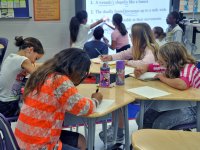Tools for Differentiating Instruction in PBL
Differentiate the content, process, and product of your PBL lessons with tools and practices like Learning Profile Cards, narrative feedback, and design thinking.
In the first few years of my career, I never understood the nuances of differentiated instruction. When asked by administrators, teachers, or parents, I would confidently proclaim that I was indeed differentiating content, process, and products for all my students, and doing it well. Reality however, was different. If pressed on how I was doing it, I knew I would devolve into incoherent teacher-speak on providing flexible due dates, shorter assignments, and the like.
While these are wonderful and needed modifications and adaptations to provide students, it took me longer than I care to admit to become cognizant of the fact that my version of differentiation had little, if any, impact on student learning. After all, if a student does not yet possess the skill to incorporate a strong claim into argumentative writing, how will his learning be any different if I assign a three-paragraph paper instead of five paragraphs? Or if a student doesn't have a home life that supports schoolwork, how will allowing her extra time to complete an assignment provide any benefit? Finally, I realized that something needed to change.
It wasn't until I discovered the project-based learning (PBL) teaching model that I encountered the instructional vehicle to deliver effective, differentiated instruction that met both my teaching philosophy and the learning needs of the students. Utilizing the Buck Institute for Education's Essential Project Design Elements, I've been able to differentiate the content, process, and product for my students in the following ways:
Differentiating Content with Learning Profile Cards
Overview
Learning Profile Cards, first introduced to me by John McCarthy, are a remarkable tool for content differentiation. The cards, which ask students to evaluate themselves on character traits and content-area strengths, as well as provide personal interests, are a great way to get to know the students.
Application
The information on the cards allows me to plan engaging, standards-based projects, along with formulating project groups based on character traits and interests. In addition, if I find myself with a student that I have particular difficulty reaching, this card provides me with multiple great reference points as conversation starters.
Why It Works
Knowing what my students are interested in helps me create a learning environment that (hopefully) makes students intrinsically want to engage.
Differentiating Process with Narrative Feedback
Overview
Narrative feedback is the process of providing students direct, actionable feedback and observations in the form of dialogue. By asking students to revise and resubmit their work, they will naturally enter a feedback loop that promotes mastery learning. I've found that the SE2R model popularized by Mark Barnes (summarize, explain, redirect, resubmit) is the most useful and straightforward model of narrative feedback.
Application
Whenever I assign a major product, I periodically review each individual work and provide feedback using the SE2R model. This feedback is anchored in the daily learning targets and provides students actionable steps toward improving the quality of their work. I've found this works best with electronic assignments, as it creates a running narrative using the comment features of many online applications.
Why It Works
The narrative feedback model provides students with individual feedback personalized to their own learning needs. In addition, if implemented as Mark Barnes suggests, it focuses student-teacher conversations on learning rather than on grades.
Differentiating Product Using Design Thinking
Overview
Design thinking is a specific process for creating solutions to problems tailored for specific individuals or groups. For example, if students throughout a school were asked to redesign their classrooms, each classroom would look different as it would be tailored to the needs of that particular group of students. In short, the design thinking process requires that students learn to empathize, brainstorm multiple ideas, prototype their thinking, and gather feedback. As creating solutions to authentic problems is an important tenet of PBL, incorporating design thinking into this process is relatively seamless.
Application
In the design thinking process, students are asked to brainstorm, or ideate, multiple solutions to the same problem. The intent with this process is that once the brainstorming is done, students are asked to prototype (build) some of their ideas to gather feedback on their feasibility.
When using design thinking, I often ask students to prototype and gather feedback on two of their ideas, the first being the idea they feel is wildest and craziest (hardest to implement) and the second being their safest idea (one they are most confident in implementing successfully). Once they receive feedback from peers or outside groups, I ask them to pick one of their two ideas to officially implement.
Why It Works
Prototyping two ideas serves to have students select ideas that most interest them, but also allows me as the teacher to steer them toward creating the product that I think will allow them the most success.
If you have any other tools for differentiating in PBL, I would love to hear them!
